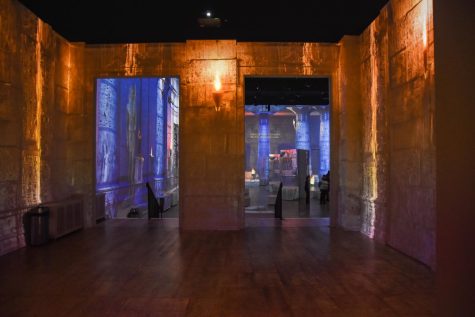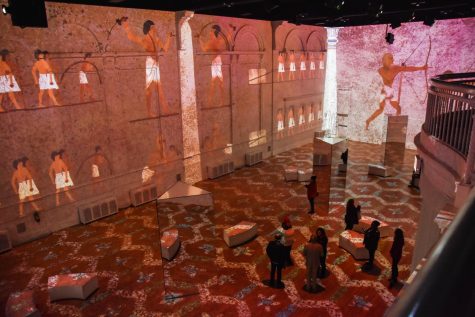Immersive King Tut commemorates 100th anniversary of the discovery of Tut’s tomb
October 24, 2022

As portrayed on the walls of the Immersive King Tut exhibit, followers of the Ancient Egyptian religion believed when the deceased’s tomb was sealed shut with their objects in it, they had 12 hours to fight the forces of the underworld. If they defeated all the forces of chaos, they would live beautifully in the afterlife forever.
The Immersive King Tut exhibit, located at 108 W. Germania Place, was produced by the creative team behind Immersive Frida Kahlo and will run until Nov. 20. At the Immersive King Tut experience, visitors learn about the pharaoh Tutankhamun’s journey to the tomb and how he saved Egypt.
One hundred years ago, on Nov. 4, 1922, the tomb of King Tut, the “boy king,” was discovered by archaeologist Howard Carter.
As a way to commemorate the finding of his tomb, the immersive experience takes guests on a journey with the pharaoh Tutankhamun as he travels through the underworld to defend the sun against the forces of chaos, bringing light again upon Ancient Egypt.

Richard Ouzounian, creative consultant at Lighthouse Immersive, said visitors of the exhibit should not expect to see the same artifacts displayed at other King Tut exhibits, such as coffins, masks and jewelry.
Ouzounian said historical exhibits often fall into patterns of cultural appropriation and focus on objects to tell the story of civilizations and people from long-ago times.
“Cultural appropriation is not a good thing … and what I said one day at a meeting is, ‘Good; we’re going to take away the what, which is the objects, but we can replace it with the who, when, where and why,’” Ouzounian said. “Let’s learn why did the Egyptians bury people? What was their religious belief? What was their spiritual beliefs? What did they think happened in the tomb?”
The gallery showcased bigger than life projections of King Tut and the sun god Amun Ra traveling the underworld on a boat encountering the forces of chaos in the underworld such as: Aphophis, the evil snake god; Khepri, the scarab beetle; Osiris, ruling god of the underworld and other forces of chaos.

Jack Braithwaithe, senior photography major at Columbia and shift lead at Lighthouse ArtSpace Chicago, said there are more interactive experiences in this exhibition, such as cameras and monitors that transform you into someone from the Ancient Egyptian era when you step into one of the interactive exhibits available, giving it a more history and science “museum-esque” experience than previous immersive experiences at Lighthouse.
“My favorite moment of working here is definitely the ability to see people come in and have a good time,” Braithwaithe said. “A lot of people [will] get to come in and experience this, and it’s something unlike most places offer.”
Ouzounian said the exhibit also makes viewers reflect on their personal beliefs.
“It’s very beautiful to see; it’s very entertaining,” Ouzounian said. “You’ll learn some Egyptian history, but if you really listen to it, you’re gonna say, ‘What do I think happens after I die?’”






